CIOs and digital leaders can’t deliver transformation alone. Technology won’t get us there if people aren’t on board. Communications, engagement, and marketing aren’t ‘add-ons’ to digital change—they’re the difference between success and failure.
The NHS is under immense pressure. NHS England is to be abolished, leadership is shifting, and the latest NHS Staff Survey confirms what we already knew—staff are struggling. Nearly half (49-51%) report feeling stressed or frustrated at work within the past week, while only 24% describe their mood as happy. The headline stat? A staggering 86% of NHS staff believe the NHS is in a ‘very weak’ or ‘fairly weak’ state. That says it all.
But there is hope—something NHS staff have always been brilliant at holding on to. Despite the challenges, 38% believe the government’s policies will ultimately improve the NHS. However, we can’t ignore the 28% who think they’ll make no difference or the 26% who fear they’ll make things worse.
Yet, even against this turbulent backdrop, digital transformation is expected to push ahead. CIOs and digital leaders are being asked to drive change in a system that feels increasingly unstable. The challenge? People won’t engage with digital transformation if they’re already at breaking point.
Technology alone won’t fix this. How we communicate, engage, and market digital transformation determines its success. If staff see digital as just another demand—another corporate priority stacked on top of their already overwhelming workload—it will fail. But if digital is framed as a genuine solution, a way to ease the daily grind, then we stand a chance.
What NHS Staff Are Telling Us
The NHS Staff Survey makes one thing clear: workload, stress, and burnout are at crisis levels. People are exhausted. They don’t have time to wade through jargon-filled emails about ‘digital innovation’. If CIOs want engagement, they need to meet staff where they are—with clear, honest, and relevant communication.
- Instead of “This new system will transform how we work in five years,” help staff experience the future through interactive tools and immersive experiences like virtual reality and 3D technology.
- Instead of “We’re implementing a new EPR,” say “Come and see how this system will make your working life easier.”
(Credit to behavioural designer and much-admired colleague Denise Hampson, whose book ‘Desire Code’ explores these ideas in depth. They absolutely have a place in the NHS.)
- Messaging matters. If digital transformation is positioned as yet another ‘strategic priority,’ it will be met with eye-rolls. But if it’s framed as a way to reduce frustration and improve working lives, people will listen.
How Comms, Engagement, and Marketing Can Drive Digital Change
1. Build Trust in a Time of Uncertainty
The NHS is in flux. Staff have seen countless initiatives come and go. The latest announcement about NHS England adds another layer of instability. People don’t just need to hear what’s changing—they need to know why they should care.
- Acknowledge uncertainty. Avoid spin. If staff feel like they’re being sold something, they’ll disengage.
- Tie digital to frontline impact, not just national strategy. National priorities shift. The need for reliable, usable systems does not.
- Communicate often and consistently. Change isn’t a one-off announcement—it’s a process.
2. Make Digital Change a Conversation, Not a Directive
Digital transformation often feels done to staff, not done with them. That’s a problem. If people aren’t engaged in shaping the change, they won’t buy into it.
- Co-design solutions with staff. The people using digital tools every day need a voice in how they’re implemented.
- Swap lengthy emails for bite-sized, engaging content. Use short videos, infographics, and real-world case studies.
- Leverage peer advocacy. Staff trust their colleagues more than leadership. Let those who have benefited from digital change share their experiences.
3. Market Digital Transformation Like It Matters
Marketing isn’t just for patients. If digital change is going to succeed, it needs internal marketing—branding, storytelling, and campaign-style rollouts that make it feel like something worth paying attention to.
- Brand digital programmes so they’re recognisable and engaging.
- Tell real stories—highlight NHS staff who have seen tangible benefits from digital tools.
- Use a multi-channel approach. Don’t rely solely on all-staff emails. Incorporate videos, intranet takeovers, team briefings, and live Q&As.
4. Protect Time for Change
Transformation takes time. But NHS staff don’t have time. Expecting them to engage with digital projects on top of everything else is unrealistic.
- Ringfence time for learning and adoption. If digital is important, people need space to engage with it.
- Offer on-demand learning. Staff can’t always attend scheduled sessions, so give them flexible options.
- Equip managers with briefing packs so they can support their teams effectively.
Winning Hearts and Minds for Digital Transformation
CIOs and digital leaders can’t deliver transformation alone. Technology won’t get us there if people aren’t on board. Communications, engagement, and marketing aren’t ‘add-ons’ to digital change—they’re the difference between success and failure.
Want to Talk About It? Get in Touch.
I’m Chloe, a communications, engagement and marketing specialist at Ethical Healthcare that helps NHS digital programmes and suppliers drive adoption, build trust, and deliver real-world impact through user-centred design. If this article resonates with you, let’s have a chat.
Email me at chloe@ethicalhealthcare.org.uk
